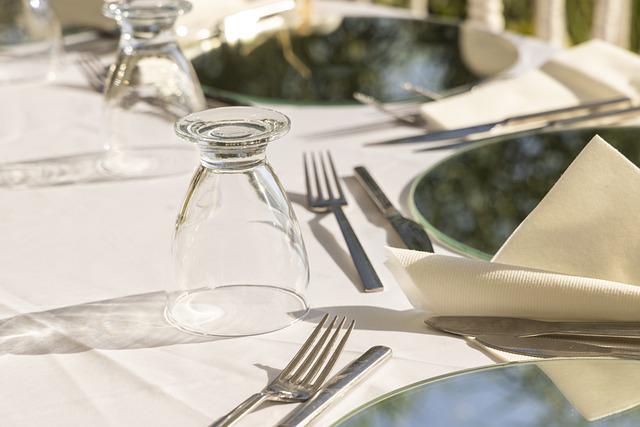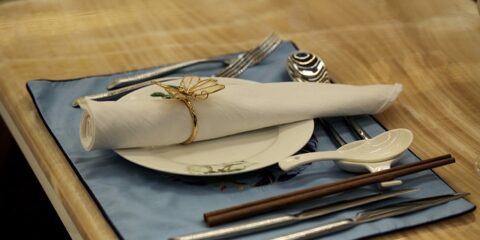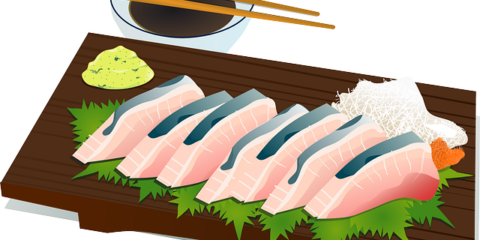Egyptian table manners
If you are invited to dine in an Egyptian house, you should take off your shoes before entering the house, and you’d better compliment the owner’s house. You can only eat with your right hand, and you must eat the second time. It is impolite to add salt to food. In addition, if you are full, you’d better leave some food on the plate, otherwise, the host will keep bringing you food.
Thai table manners
| Thai people often eat on the ground but be careful not to point their feet at others. Bow your head before the statue of Bodhisattva and the king. If you bring a gift to a Thai family, you should wrap it up so that people can see the price tag. Because the host may give you a gift in return. If the value of the gift is lower than your gift, the host will be embarrassed. |
| Don’t put food in your mouth with a fork |
| A fork is used to put food in a spoon. Forks can only be used in this way for separate nonrice foods. If you want to use the seasoning placed in front of other guests at the same table, you should ask the guests sitting next to you to help pass it. Do not stretch out your hand to cross. |
| When taking vegetables and soup, use chopsticks and spoons |
| When seated, keep your feet under your seat. Do not stretch out at will. Do not lean your elbows against the edge of the table or put your hands on the back of the adjacent seat |
| It’s very unlucky to put chopsticks in a bowl. Dinner is actually a social occasion. The richest person will naturally pay the bill. |
Korean table manners
| If your elders pour you wine, take the cup with both hands. After taking the cup, take a sip gently to show respect. Don’t eat before your elders start eating. |
| Give dinner to the elderly first. If you are invited to a Korean home for dinner, don’t rush. Because it’s not rude to be half an hour late. Take off your shoes before entering the door. At the dinner table, the elderly are served rice first, which means they can have dinner. When eating rice, stews, and soup, use spoons and chopsticks for other meals. Remember not to point at people with chopsticks or poke food with chopsticks. It is polite not to leave leftovers in the bowl. |
| When dining with the elders, the elders can only move the chopsticks after the younger generation. |
| Do not hold the spoon and chopsticks in your hand at the same time; Don’t put the spoon and chopsticks in the bowl; Don’t eat and drink soup with a bowl. |
| Drink soup before eating other foods; Don’t make any noise when eating. Don’t let the spoon and chopsticks touch the bowl and make a sound. |
| The shared food should be put on their own plates and eaten later. Vinegar sauce and chili sauce should also be dipped on the plates. |
| When swallowing bones or fish bones, avoid others and wrap them in paper before throwing them away. Don’t throw them directly on the table or the ground. Don’t eat too fast or too slowly. Keep pace with others. When dining with the elders, wait until the elders put down the spoon and chopsticks. |
| After the meal, the spoon and chopsticks are placed in the original position, and the used napkins are stacked on the table. |
Japanese table manners
| Eating noodles with soup makes a loud sound. In the eyes of foreigners, Japanese table manners are very particular, but eating noodles seems to be an exception. The Japanese make no secret of their noise when eating soup noodles, and they will certainly make a loud sound of sucking. Tourists had better do as the Romans do in Rome to show their appreciation for the hospitality of the host. In addition, when eating rice or soup, be sure to put the bowl up and let the mouth of the bowl facing you. |
| Don’t put your chopsticks in the rice bowl vertically. When you don’t use them, put them horizontally and parallel in one corner of the table. It is taboo in Japan to insert chopsticks vertically into a rice bowl. |
| Don’t use chopsticks to find what you like to eat in the dish. Pull it around. After holding out the chopsticks, he hesitated, not knowing which dish to take. |
| It is forbidden to use chopsticks to stick (instead of the clip) food. Don’t put your mouth on the edge of the rice bowl. It’s forbidden to eat with chopsticks. Don’t beat the tableware with chopsticks. |
| Don’t put a lot of food in your mouth with chopsticks. Don’t pass food on with chopsticks. Don’t hold chopsticks in your palm. |
| Don’t drip dishes or soup on your chopsticks. |
French table culture
| In France, if the food is seasoned before it is tasted, the chef will be very unhappy. Moreover, guests must turn off their mobile phones before eating to avoid being interrupted. It’s rare to use dessert plates to hold the bread, so just put the bread on the tablecloth. Only when you want to add wine, drink it up in one gulp, otherwise, you’d better have some left. |
| Don’t treat bread as an appetizer. In France, starch mixtures, especially those with cream, are eaten after meals. |
Canadian Inuit table culture
A burp after dinner will make the host very happy. If you have the opportunity to sit with the Inuit people in Canada, a burp after dinner will make the host very happy, because it will be regarded as another form of gratitude. Some Inuit families are still “using chopsticks” in the same pot. Generally, men eat first, followed by women and children. Sometimes the Inuit people just grab the meat in the pot with their hands without a spoon. As a guest, you have to do as the Romans do in Rome.
Russian table culture
| Don’t mix vodka with other wines or drinks, and don’t refuse vodka given to you by others. Mixing other wines or drinks in the wine is regarded as undermining the purity of the wine while refusing others’ vodka is regarded as you don’t trust the other person and don’t want to be friends with him. |
| Vodka that can’t be refused. Russians are hospitable. When the host hands you a glass of vodka, you must not refuse it out of politeness. Men should drink it all at once, while women don’t. And when making a toast, you should look directly at the other person. The sauce or gravy in the meal should be dipped in bread. If the bread is left, it will be regarded as an unlucky and wasteful thing. |
Table manners in Ethiopia
Ethiopians have the habit of feeding each other, which seems to be a very unhygienic thing. In particular, you have to grab a meal with gravy, feed it to your neighbor, and then feed it to others on the table. This also means that the food you eat in your mouth has passed through the hands of the whole table
Philippine table manners
In the Philippines, to be a qualified guest, you must learn to wait and obey. When the host asks you to sit down, you can sit down again, tell you where to sit, and ask you when to start eating. If the host doesn’t add food to you, you can’t take the initiative. Only doing so is considered polite.
Lebanese table manners
In order to show their hospitality, Lebanese people often serve their guests two or three times. Therefore, when serving the first batch of dishes, you’d better eat less, so that you can have enough energy to fight a protracted war. The longer the meal, the more the host’s enthusiasm can be shown, and it also means that the guests enjoy the host’s food. If it’s traditional Middle Eastern food, you’d better eat it in rolls.
Afghan table manners
On the Afghans’ dining table, the guests are the ones who have the first bite of food, eat the most, and have the seats farthest from the door. Be careful not to drop the food on the ground. If you accidentally drop a piece of bread, you should pick it up, kiss it, hold it up to your forehead, and then put it down. This series of actions is to show respect for food.
Mexican table manners
Don’t use cutlery when eating tacos. Using cutlery when eating tacos is considered stupid and snobbish. Don’t be a snob.
Chinese table manners
Don’t turn the fish. In southern China and Hong Kong, turning the fish during meals will bring bad luck. Either do not eat the fish on the other side or take the fish bones to eat the fish on the other side.
Table manners in the Middle East
When you drink coffee with Bedouin people, shake the cup at the end. If you don’t shake the cup, the waiter will continue to fill your coffee as soon as you finish drinking. If you don’t want to drink, remember to tilt the glass two or three times.
Chilean table manners
| Don’t take anything with your hands |
| In South America, dining etiquette is very formal. |
| √ invite women to take their seats first. |
| × Hold a knife and fork and talk to others. |
Italian table manners
| Do not ask the waiter for ingredients unless they are provided |
| In Italy, it is considered evil to add cheese to pizza. In fact, many Italian dishes don’t need extra ingredients. Only drink a cappuccino before noon. If you drink a cappuccino in the afternoon, you will be labeled as a tourist. If you want to drink, have a cup of espresso. |
Georgian table manners
If you attend a traditional banquet, people usually drink it all at one time.
Britain Table manners
| When seated, keep your body upright. Do not put your elbows on the table. Do not cross your feet. Do not fiddle with the tableware that has been set on the dining table. Fold the napkin in half and gently place it on your lap. |
| When eating with a knife and fork, take the knife and fork from the outside to the inside. Hold the fork with your left hand and the knife with your right hand. When using the knife, the blade must not be outward. When putting down the knife and fork during the meal, the knife and fork should be placed in an “eight” shape and placed on the edge of the plate respectively. The blade is facing toward itself, which means that you will continue to eat. After each dish, put the knife and fork together on the plate. If it is a conversation, you can hold a knife and fork without putting them down. When you do not use a knife, you can hold the fork with your right hand. However, if you need to make a gesture, you should put down the knife and fork. Do not swing the knife and fork in the air with your hand. Do not hold a knife or fork in one hand and wipe your mouth with a napkin in the other hand. Do not hold a wine cup in one hand and take vegetables with a fork in the other hand. |
| Don’t make any noise when you drink soup. Shut up and chew when you eat. |
| Bread is usually broken into small pieces and sent to the mouth. Don’t bite the whole piece of bread. |
| When drinking coffee, you should hold a cup handle in your right hand and a dish in your left hand, and drink it directly with your mouth. Don’t drink it with a spoon. |
| √ hold a fork in the left hand and a knife in the right hand. |
| × His mouth was full of food when he spoke. |
German table manners
| When eating, cut as much food as possible. In Germany, this is intended to praise the chef for his superb skills and excellent taste in the food. |
| Cut lettuce while eating salad. Diners may as well fork up with a fork. |
| If you drink beer and wine at the same time, you should drink beer first and then wine, otherwise, it will be considered harmful to your health |
| Too much food should not be piled on the plate. |
| Do not use a napkin to fan around |







